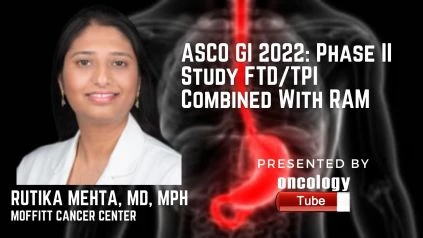Rutika Mehta, MD, MPH from Moffits Cancer Center. In this interview, Dr. Mehta speaks about the ASCO GI 2022 Abstract – A phase II study of TAS-102 (FTD/TPI) in combination with ramucirumab (RAM) in advanced, refractory gastric (GC) or gastroesophageal junction (GEJ) adenocarcinomas (GEAs).
Â
Context:
Â
After the failure of fluoropyrimidine and platinum-based chemotherapy, the RAINBOW study established the standard of care for treating metastatic GEAs with ramucirumab and paclitaxel. While the combination had a 28 percent objective response rate (ORR), there was a 46 percent incidence of any grade neuropathy. As a result, there is an unmet need for innovative therapy combinations that reduce neuropathy’s long-term damage. The combination of RAM+TAS-102 exhibited effective disease control and a tolerable toxicity profile in a newly published Asian research.
Â
Methodologies:
Â
The combination of TAS-102 and RAM was used in this single-arm, single-institution phase II trial in refractory GEAs. Every 28-day cycle, patients (pts) received RAM 8mg/kg intravenously on days 1 and 15, as well as TAS-102 35mg/m2 orally twice daily on days 1-5 and days 8-12. The primary outcome was the 6-month overall survival (OS) rate, with progression free survival (PFS), ORR, and safety profile as secondary endpoints. www.clinicaltrials.gov was used to register the trial (NCT03686488).
Â
Outcomes:
Â
There were 23 points enrolled at the data cut-off date of August 15, 2021. The following are the baseline demographics: median age of 62 years (range: 23-74), median lines of prior therapy of 1 (1: 14 pts vs 2: 9 pts), and main tumor site (GEJ:19 vs GC: 4). The OS rate was 56.2 percent after six months. With a median observation of 2.3 months, the median OS was 6.2 months (95 percent CI: 5.4-7.0) and the median PFS was 4.9 months. 1 (6%) of the 17 evaluable patients with more than one baseline imaging exhibited a partial response (PR), while 15 (88%) had stable disease (RECIST v1.1). Eleven points were removed from the research due to illness progression, eight for toxicities, and four for withdrawal of consent. Diarrhea (39 percent), tiredness (39 percent), and hypertension were the most prevalent treatment-emergent adverse events (TEAEs) (39 percent ). A total of 11 patients (48%) had grade 3 and 4 TEAEs, with neutropenia (17%) and anemia (17%) being the most common Gr3 and 4 TEAEs (13 percent ).
Â
Findings:
Â
The combination of RAM and TAS-102 had a disease control rate that was quite similar to the Asian trial. The combination has now showed modest effect in advanced GEAs and should be further examined in patients undergoing immunotherapy-based treatment as a first-line treatment. Patients taking ramucirumab and TAS-102 or paclitaxel are now being enrolled in a randomized phase II research. NCT03686488 is the number for the clinical trial.

